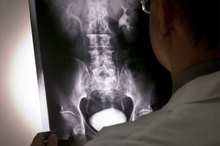Adult Complications of Spina Bifida Occulta
Spina bifida occulta is a physical deformity that occurs as a baby develops in the mother's womb. The bones around the spinal cord fail to develop normally, but the nerves don't generally have any damage. Skin on the child’s back is generally normal; however, there can be a dimple, a hair patch or a red discoloration directly over the affected area. Babies who are born with spina bifida occulta do not usually experience any effects. As they grow into adulthood, they may experience complications that change their medical care.
If you are experiencing serious medical symptoms, seek emergency treatment immediately.
Tethered Cord
According to Children's Hospital Boston, as a baby develops the spinal cord begins as a flat plate of cells 1. It later rolls into a tube encased inside the spine. The spine will grow faster than the cord. When there are no impediments, the cord will move up and down freely in the channel within the spine. However, sometimes the spinal cord becomes attached to the surrounding tissue, usually at the base of the back where the spina bifida occulta has occurred. When the cord becomes tethered, the individual will experience neurological deficits that include weakened lower extremities and bowel and bladder dysfunction.
Researchers from the University of Wisconsin Medical School published their findings in the "Journal of Neurosurgery Spine" regarding the presentation of tethered cord syndrome in adults who suffered from spina bifida occulta 2. They found that although the presentation is unusual, surgical correction holds relatively low risk and offers potential for neurological stabilization.
- According to Children's Hospital Boston, as a baby develops the spinal cord begins as a flat plate of cells 1.
- Researchers from the University of Wisconsin Medical School published their findings in the "Journal of Neurosurgery Spine" regarding the presentation of tethered cord syndrome in adults who suffered from spina bifida occulta 2.
Pregnancy
Complications of Spinal Fusion With Harrington Rods
Learn More
According to the Spina Bifida Association, the ability to become pregnant is not significantly affected by the spinal deformity 3. However, the ability to maintain the pregnancy to term can be impacted by the level of the spina bifida occulta and any previous abdominal surgeries. Women with spina bifida will have structural changes to the uterus while those who experience spina bifida occulta generally do not. However, the occulta abnormality can cause lower body inflexibility and difficulties with potential tethered cord that will impact the ability of a woman’s body to maintain a pregnancy.
- According to the Spina Bifida Association, the ability to become pregnant is not significantly affected by the spinal deformity 3.
- However, the ability to maintain the pregnancy to term can be impacted by the level of the spina bifida occulta and any previous abdominal surgeries.
Syringomyelia
According to the Chiari and Syringomyelia Foundation, a syringomyelia may be the result of a tethered spinal cord 4. The area of the syrinx, or fluid filled cyst, will help to dictate the type of treatment that will be considered. In some cases this may respond to a tethered cord release. Symptoms of a syringomyelia include muscle weakness, loss of reflexes and loss of sensitivity to pain and temperature 4. Other symptoms can include stiffness, pain, bowel and bladder function problems and tingling sensation in the trunk and into the legs.
Related Articles
References
- "Journal of Neurosurgery Spine"; Tethered cord due to spina bifida occulta presenting in adulthood
- Chiari and Syringomyelia Foundation: Syringomyelia
- Spina Bifida Association. What is spina bifida? SBA National Resource Center.
- National Institute of Neurological Disorders and Stroke. Spina Bifida Fact Sheet. Updated March 17, 2020.
- Centers for Disease Control and Prevention. Living with Spina Bifida: Toddlers and Preschoolers. Updated September 5, 2019.
- Spina Bifida Association. Genetics and spina bifida. SBA National Resource Center.
- Centers for Disease Control and Prevention. Data & Statistics on Spina Bifida. Updated September 3, 2019.
- Atta CA, Fiest KM, Frolkis AD, et al. Global Birth Prevalence of Spina Bifida by Folic Acid Fortification Status: A Systematic Review and Meta-Analysis. Am J Public Health. 2016;106(1):e24-34. doi:10.2105/AJPH.2015.302902.
- Centers for Disease Control and Prevention. Use of Antiepileptic Medications During Pregnancy and the Potential Impact on Birth Defects. Updated November 1, 2018.
- National Institutes of Health. Spina bifida. Updated August 8, 2017.
- Adzick NS, et al. A randomized trial of prenatal versus postnatal repair of myelomeningocele. New England Journal of Medicine. 2011 Mar 17;364(11):993-1004. doi:10.1056/NEJMoa1014379
- Phillips LA, Burton JM, Evans SH. Spina Bifida Management. Curr Probl Pediatr Adolesc Health Care. 2017;47(7):173-177. doi: 10.1016/j.cppeds.2017.06.007.
Writer Bio
Gail Morris has been writing extensively since 1997. She completed a master's degree in nursing at Indiana University-Purdue University Indianapolis and practiced in medicine for more than 20 years. Morris has published medical articles in peer-reviewed journals and now writes for various online publications and freelances for Internet marketers.









